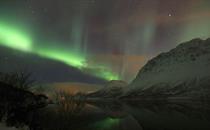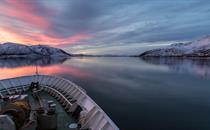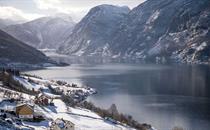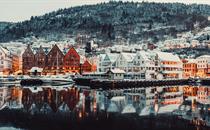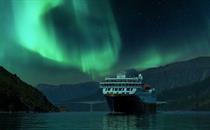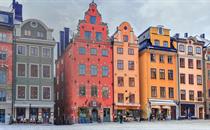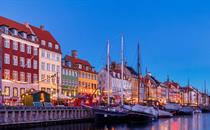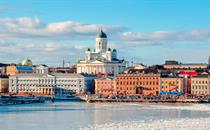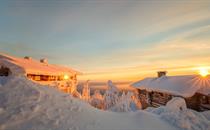FREQUENTLY ASKED QUESTIONS ABOUT VISITING NORWAY IN JANUARY
If you’re wondering where to go in Norway in January and what to see and do, we’ve got you covered. Read on to learn all about tours to Norway in January with these answers to commonly asked questions.
What are the best things to do in Norway in January?
January is a great time to enjoy winter tours in Norway and tick off some bucket list experiences. You can make the most of outdoor activities in the snow and visit top sites with fewer visitors around.
Here are 10 of the best things to do in Norway in January:
-
Spot the dancing aurora borealis in the night sky
-
Stay in a hotel made of snow and ice
-
Enjoy a Havila cruise or Hurtigruten coastal voyage along the west coast
-
Marvel at stunning scenery on a Norwegian fjord cruise
-
Dine at top contemporary restaurants in Oslo, Bergen and Trondheim
-
Learn about Sami culture in Northern Norway
-
Have a go at dog sledding, ice fishing or Arctic trucking
-
Travel between Oslo and Bergen on the Norway in a Nutshell® tour
-
Try snowmobiling, snowshoeing or cross country skiing in the countryside
-
Watch live music performances at the Northern Lights Festival in Tromsø
Good to know: The Norwegian experts at Nordic Visitor will make sure your itinerary is tailored to your taste. Add activities like dog sledding or snowmobiling to your tour or even shore excursions as you cruise Norway in January. You could visit charming Ålesund and the Lofoten islands.
Plus, you’ll get all the signature Nordic Visitor benefits. These include access to our 24/7 helpline, a detailed personal itinerary, helpful travel guide and daily breakfast.
What are the best places to visit in Norway in January?
In January you can visit Northern Norway for aurora borealis tours and winter activities in the snow. Meanwhile in Western Norway, you can visit the iconic fjords without the crowds.
Here are some of the best places to visit in Norway in January:
-
Explore the capital
Oslo and its many highlights and museums
-
Visit
Tromsø to chase the northern lights in Norway’s aurora capital
-
-
-
Experience snow like never before in
Kirkenes
-
Stroll through the “Gateway to the Fjords”,
Bergen
-
-
Sail north to see jewels of Arctic Norway like the
North Cape
-
Venture off the beaten path to
Camp Tamok near Tromsø
If the northern lights are on your bucket list, January is a fantastic time to visit Norway. The “northern lights belt” (also called “aurora belt”) passes directly through Northern Norway. This means the best places to go for viewing the aurora borealis are the Arctic towns of Tromsø or Kirkenes.
What is the weather like in Norway in January?
January falls in the middle of winter in Norway, so the weather is cold and the days are short. Temperatures are below freezing in most parts of Norway and the country is beautifully blanketed with snow. It is as expected for a country that stretches into the Arctic Circle!
What is the temperature in January?
As the country spans such a large distance, temperatures in Norway vary depending on location. The west coast is milder than the rest of the country due to the Gulf Stream.
In Oslo the average temperature is -4°C (24°F) in January, while in Bergen and Stavanger it is 1°C (34°F). In Tromsø the average temperature is -4°C (24°F), and in Longyearbyen, the main town of Svalbard, it is -13°C (9°F).
Does it snow in Norway in January?
Yes, you can expect plenty of snow-covered landscapes during your tour of Norway in January. It’s an ideal time to take part in activities such as snowmobiling or dog sledding.
What are the driving conditions in Norway in January?
Driving in Norway in winter is likely to be different than what you’re used to back home, even if you’ve experienced snowy, icy conditions before. Winter storms can bring high winds, poor visibility and slippery surfaces.
Driving over mountain passes can also require extra caution in January. It’s important to note that some roads are closed over the winter months. If you want to take the wheel on a road trip, we recommend you visit Norway between May and September instead.
Or, if you’d like to travel with a local guide and like-minded visitors, plan your trip for the summer to join a guided small group tour of Norway. The tour guides will take you to the best spots and share their insider knowledge with you. Southern Norway is especially beautiful in the summer!
What to pack for a trip to Norway in January?
The weather in January is cold, so you must bring suitable layers and protective gear. That way, come rain or shine, you can enjoy the natural beauty of the country.
Here is a packing list for your Norway trip in January:
-
Insulated and waterproof jacket
-
Wool jumpers
-
Waterproof or snow trousers
-
Insulated boots with a good grip
-
A warm hat, gloves and scarves
-
Thermal socks and underwear
If your tour includes activities like dog sledding or snowmobiling you may also wish to bring glove liners, a balaclava and maybe even warmer heat packs. Some excursions will provide thermal suits for your protection, but make sure to check details before departing on your adventure.
What to wear in Norway in January?
In the Nordic countries, they have a saying: “There is no such thing as bad weather, just bad clothing”.
When travelling to Norway in January, you can expect cold temperatures outdoors. They may feel even colder with the strong coastal winds (wind chill factor). To enjoy all your winter activities, come prepared with warm underlayers and insulated outer layers.
What are the daylight hours in Norway in January?
In January the days are some of the shortest in the year. In the south, you’ll experience 6-8 daylight hours. In the north, expect a maximum of 5 hours of daylight.
There is a big difference in daylight hours between the beginning and end of the month. In early January, the sun rises at 9:20 AM and sets at 3:20 PM in Oslo. In Tromsø, the sun does not rise for the first 2 weeks of January, a phenomenon called the “polar night”.
By the end of the month, the sun rises at 8:30 AM in Oslo and sets at 4:20 PM. In Tromsø, the sun rises at 9:30 AM and sets at 2:30 PM by the end of January.
Can I see northern lights in Norway in January?
Thanks to the long, dark nights of winter, January is a great time to chase the auroras in Norway. The darker and clearer the skies, the more chances you have of witnessing the incredible solar activity. That’s why winter is the best time to search for the northern lights.
The optimum place to look for the aurora borealis is towards the Arctic Circle. We recommend you head to Northern Norway with a stay in Tromsø or Kirkenes.
Is it better to visit Iceland or Norway in January?
Both Norway and Iceland have their own appeal and reasons to visit in January. The great thing about both is that there are fewer visitors at top attractions, as winter is a quiet travel season.
You can try your luck hunting for the northern lights in Iceland and Norway in January. Both of these Nordic countries are situated within the “aurora belt”, which means that they are prime locations for witnessing this natural phenomenon.
There are so many other exciting activities to enjoy in January. For example, both Norway and Iceland offer the chance to go whale watching, snowmobiling, and experience Nordic spa traditions.
In Northern Norway, you could stay in a hotel made of snow and ice. You can also go dog sledding, try ice fishing, or head out on a king crab safari. In Iceland, on the other hand, you could marvel at staggering waterfalls, glaciers, volcanoes and ice caves.
If you’re struggling to choose between visiting Norway or Iceland in winter, then don’t! You could easily combine them on a multi-country trip, hopping from one to the other on a short 3-hour flight between Oslo and Reykjavík.
As a Northern European tour operator, Nordic Visitor specialises in organising trips to this beautiful corner of the world. We have many more ideas and travel tips to help you explore the region your way!
Good to know: Nordic Visitor’s itineraries aren’t set in stone. Our travel experts know their destinations inside out and will tailor your tour to suit you.
Scroll down to learn more about Nordic Visitor’s services.
